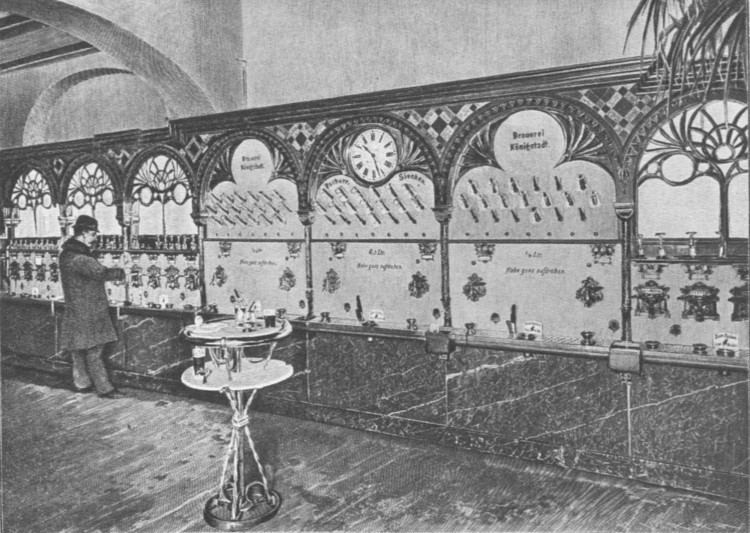 | ||
An automat is a fast food restaurant where simple foods and drink are served by vending machines.
Contents
Concept
Originally, the machines in U.S. automats took only nickels. In the original format, a cashier sat in a change booth in the center of the restaurant, behind a wide marble counter with five to eight rounded depressions. The diner would insert the required number of coins in a machine and then lift a window, hinged at the top, and remove the meal, usually wrapped in waxed paper. The machines were replenished from the kitchen behind. All or most New York automats had a cafeteria-style steam table where patrons could slide a tray along rails and choose foods, which were ladled from tureens.
Inspired by Max Sielaff's AUTOMAT Restaurants in Berlin, they became among the first 47 restaurants, and the first non-Europeans to receive patented vending machines from Max Sielaff's AUTOMAT GmbH Berlin factory, Ludwig Stollwerck, creators of the first chocolate bar vending machine. The first automat in the US was opened June 12, 1902, at 818 Chestnut St. in Philadelphia by Horn & Hardart. The automat was brought to New York City in 1912 and gradually became part of popular culture in northern industrial cities. Horn & Hardart was the most prominent automat chain.
The automats were popular with a wide variety of patrons, including Walter Winchell, Irving Berlin and other celebrities of the era. The New York automats were popular with unemployed songwriters and actors. Playwright Neil Simon called automats "the Maxim's of the disenfranchised" in a 1987 article.
Decline
The format was threatened by the arrival of fast food, served over the counter and with more payment flexibility than traditional automats; in the 1970s, the automats' remaining appeal in their core urban markets was strictly nostalgic. Another contributing factor to their demise was inflation of the 1970s, making the food too expensive to be bought conveniently with coins, in a time before bill acceptors commonly appeared on vending equipment.
At one time there were 40 Horn & Hardart automats in New York City alone. The last one closed in 1991. Horn and Hardart converted most of its New York City locations to Burger Kings. At the time, the quality of the food was described by some customers as on the decline.
In an attempt to bring back automats in New York City, a company called Bamn! opened a new East Village store in 2006, but it closed in 2009.
Rail transport
Another form of the automat was used on some passenger trains. The Great Western Railway in the United Kingdom announced plans in December 1945 to introduce automat buffet cars. Plans were delayed by impending nationalisation, and an automat was finally introduced on the Cambrian Coast Express, in 1962.
In the United States, the Pennsylvania Railroad introduced an automat between Pennsylvania Station, New York City and Union Station, Washington, DC, in 1954. Southern Pacific Railroad introduced automat buffet cars on the Coast Daylight and Sunset Limited in 1962. Amtrak converted four buffet cars to automats in 1985 for use on the Auto Train. The last one in use in the United States was on the short-lived Lake Country Limited in 2001.
In Switzerland, Bodensee–Toggenburg Bahn introduced automat buffet cars, in 1987.
Japan
In Japan, in addition to regular vending machines which sell prepared food, many restaurants also use food ticket machines (食券機, shokkenki), where one purchases a meal ticket from a vending machine, then presents the ticket to a server, who then prepares and serves the meal. (See Wikipedia in Japanese for an example.) Conveyor belt sushi restaurants are also popular.
Netherlands
The Dutch FEBO stores provide a variety of burgers, sandwiches, frikandellen and croquettes in vending machines that are back-loaded from a kitchen. Their automat is called automatiek. FEBO snack bars sell various hot, deep fried snacks. These outlets are open 24 hours, and are popular with locals, and those leaving clubs and bars late at night.
Spain
In Spain, one can also find the typical Dutch automat machines. For example, a complete automatic restaurant is installed in a University Jaume I of Castellón. Fresh healthy hot plates are sold from the hot food vending machines. The cold versions provide freshly made salads.
